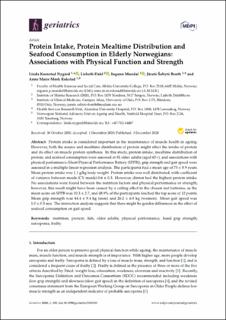Protein intake, protein mealtime distribution and seafood consumption in elderly Norwegians : associations with physical function and strength
Nygård, Linda Anette Kornstad; Dahl, Lisbeth; Mundal, Ingunn Pernille; Saltyte Benth, Jurate; Rokstad, Anne Marie Mork
Peer reviewed, Journal article
Published version

View/
Date
2020Metadata
Show full item recordCollections
- Articles [3011]
- Publikasjoner fra CRIStin [3061]
Original version
10.3390/geriatrics5040100Abstract
Protein intake is considered important in the maintenance of muscle health in ageing. However, both the source and mealtime distribution of protein might affect the intake of protein and its effect on muscle protein synthesis. In this study, protein intake, mealtime distribution of protein, and seafood consumption were assessed in 92 older adults (aged 65+), and associations with physical performance (Short Physical Performance Battery (SPPB)), grip strength and gait speed were assessed in a multiple linear regression analysis. The participants had a mean age of 73 ± 8.9 years. Mean protein intake was 1.1 g/kg body weight. Protein intake was well distributed, with coefficient of variance between meals (CV meals) 0.6 ± 0.3. However, dinner had the highest protein intake. No associations were found between the nutrition factors and physical performance or strength; however, this result might have been caused by a ceiling effect in the chosen test batteries, as the mean score on SPPB was 10.3 ± 2.7, and 48.9% of the participants reached the top score of 12 points. Mean grip strength was 44.4 ± 9.4 kg (men) and 26.2 ± 6.8 kg (women). Mean gait speed was 1.0 ± 0.3 m/s. The interaction analysis suggests that there might be gender differences in the effect of seafood consumption on gait speed. Keywords: nutrition, protein, fish, older adults, physical performance, hand grip strength, sarcopenia, frailty